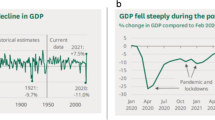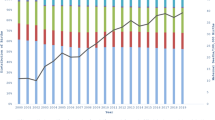Abstract
A study was carried out to determine factors affecting place of death (home, hospital, nursing home or “other places”) among all 426,115 resident deaths in Washington State during 1968–1981, using death certificate information. Sixteen percent of deaths occurred at home, 74% in institutions (51% in hospitals, 23% in nursing homes) and 9% at “other places.” Age, marital status and cause of death all strongly affect place of death. Further, the effect of each factor was strongly dependent on the others. Sex had no effect on place of death after controlling for other factors. Elderly people died relatively more frequently in nursing homes, infants and middle aged people in hospitals and young adults in “other places.” The frequency of deaths at home was quite constant by age. Hospitals were the most common place of death following both vascular disease (including heart attack) and neoplasms, and nursing homes were the most common place of death following cerebrovascular disease (including “stroke”). Race, socioeconomic status and urban or rural residents affected the place of death only slightly or not at all. The place of death pattern changed little during the time period 1968–1981, except for a slight increase in frequency of home deaths and a corresponding decrease in the frequency of deaths in other places.
Among cancer patients, the likelihood of death at home was positively associated with longer periods of survival after diagnosis. Cancer patients of hospitals serving targeted populations, such as veterans, were relatively more likely to die in a hospital and less likely to die in a nursing home compared to other cancer patients, suggesting that the “targeted” hospitals are sometimes serving a nursing home function. There was a marked difference in the terminal cancer caseload by hospital. The number of cancer deaths per cancer diagnosis varied widely across hospitals (0.1 to 1.6) and was unrelated to size of the hospital or level of services offered.
Intervention aimed at affecting place of death, such as increasing the number of deaths at home, will need to take account of the joint effect of age, marital status and disease.
Similar content being viewed by others
References
Lerner, M: When, why and where people die. In OG Brim, HE Freeman, S Levine and NA Scotch (Eds.)The Dying Patient. New York: Russell Sage Foundation, 1970.
Vicker, RL, The hospice movement in the United States.Long Term Care and Health Services Administratio 3:253–283, 1979.
Callan, JP, The hospice movement.JAMA 241:600, 1979.
Leone, LA, The concept of hospice.CA 32: 141–143, 1982.
Robinson, BE, Hospice (letter).CA 33:60, 1983.
Leone, LA, Hospice (letter).CA 33:191–192, 1983.
Cartwright A, Hockey L, Anderson JL:Life Before Death. Boston: Routledge & Kegan Paul, 1973.
Katz BP, Zdeb MS, Therriault GD, Where people die.Public Health Rep 94:522–527, 1979.
McCusker J, Where cancer patients die. An epidemilogic study.Public Health Rep 98:170–176, 1983.
Flynn, A and Stewart, D, Where do cancer patients die?J of Community Health, 5:126–130, 1979.
Halper, T, On death, dying and terminality: Today, yesterday and tomorrow.J Health, Polit, Policy Law 4:11–29, 1979.
Kassakian MG, Bailey LR, Rinker M, Stewart CA and Yates JW, The cost and quality of dying: A comparison of home and hospital.Nurse Pract 4:18–19, 22–23, 1979.
Dempsy D:The Way We Die: An Investigation on Death and Dying in America. New York: MacMillan, 1975.
Amado A, Cronk BA, Mileo R. Cost of terminal care: Home hospice vs. hospital.Nurs Outlook 27:522–526, 1979.
Bloom, BS and Kissick, PD, Home and hospital cost of terminal illness.Med Care 18:560–564. 1980.
Krant, MJ, The hospice movement.New Engl 299:546–549, 1978.
Krakoff, IH. The case for active treatment in patients with advanced cancer: Not everyone needs a hospice.CA 29:108–111, 1979.
Hinton, J, Comparison of places and policies for terminal care.Lancet 1:29–32, 1979.
Sampson, WI, Dying at home.JAMA 238:2405–2406, 1977.
Smith, CA and Hill, PDH, Grieving responses: A comparison after home or hospital care.NZ Med J 88:393–395, 1978.
Soukop, M and Calman, KC, Cancer patients: Where do they die—an analysis.Practitioner 219:883–888, 1977.
Walter, NT, Continuing care of the cancer patient as a social engineering problem.Cancer Res 39:2859–2862, 1979.
Zimmerman, JM, Experience with a hospice-care program for the terminally ill.Ann Surg 189:683–690, 1979.
1980 U.S. Census Bureau publication #PC80-1-B49. General Population Characteristics for Washington State. Issued August, 1982.
Surveillance, Epidemiology, End Results (SEER): Incidence and mortality data: 1973–1977. NCI Monograph 57. Bethesda, MD, 1981.
International Classification of Diseases. 1965 Revision, World Health Organization, 1967.
International Classification of Diseases, 1975 Revision, World Health Organization, 1977.
Additional information
Lincoln Polissar, Ph.D., is Associate Member, Fred Hutchinson Cancer Research Center, Division of Public Health Sciences, Seattle, WA and Associate Professor, Department of Biostatistics, University of Washington in Seattle. Richard K. Severson, M.S., is the Project Coordinator, Fred Hutchinson Cancer Research Center. Norman K. Brown, M.D., is Clinical Professor of Medicine, School of Medicine, University of Washington.
This research was supported by NCI Grant Nos. NCI-SR18, CA 29770–03 Requests for reprints should be sent to Lincoln Polissar, Ph.D., Fred Hutchinson Cancer Research Center, 1124 Columbia Street, Seattle, WA 98104
Rights and permissions
About this article
Cite this article
Polissar, L., Severson, R.K. & Brown, N.K. Factors affecting place of death in Washington State, 1968–1981. J Community Health 12, 40–55 (1987). https://doi.org/10.1007/BF01321396
Issue Date:
DOI: https://doi.org/10.1007/BF01321396




